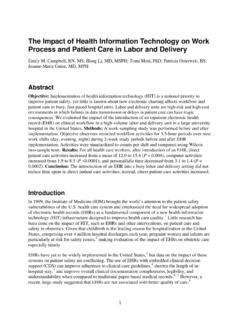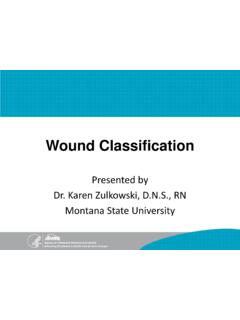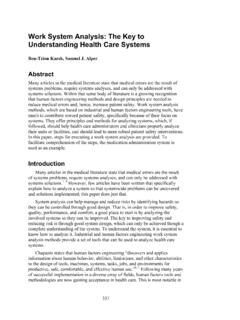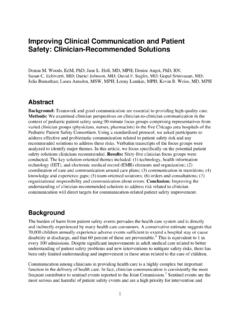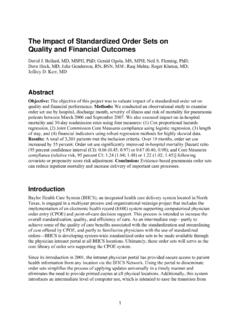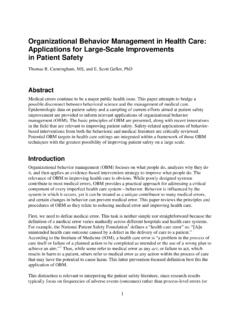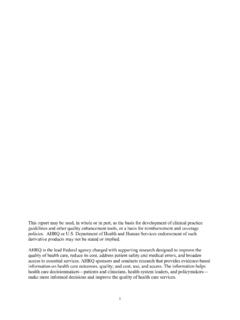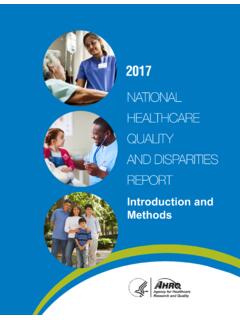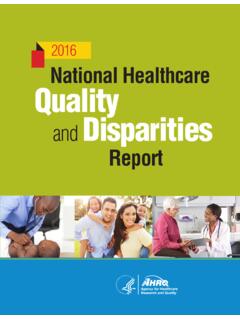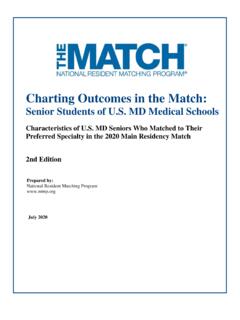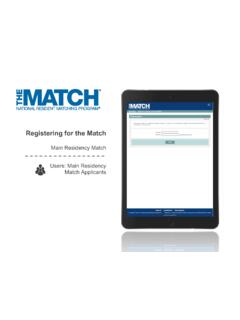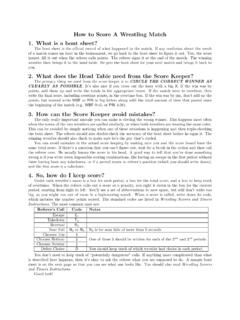Transcription of Medications at Transitions and Clinical Handoffs (MATCH ...
1 Medications at Transitions and Clinical Handoffs ( match ) Toolkit for Medication ReconciliationMedications at Transitions and Clinical Handoffs ( match ) Toolkit for Medication Reconciliation Prepared for: Agency for Healthcare Research and Quality Department of Health and Human Services 540 Gaither Road Rockville, MD 20850 No. HHSA2902009000 13 CPrepared by: Northwestern Memorial Hospital Chicago, Illinois Kristine Gleason, Helga Brake, Peer Review Organization, Inc. Lake Success, New York Victoria Agramonte, , Carrie Perfetti, Publication No. 11(12)-0059 Revised August 2012iiThis document is in the public domain and may be used and reprinted without permission except those copyrighted materials that are clearly noted in the document. Further reproduction of those copyrighted materials is prohibited without the specific permission of copyright Citation:Gleason KM, Brake H, Agramonte V, Perfetti C.
2 Medications at Transitions and Clinical Handoffs ( match ) Toolkit for Medication Reconciliation. (Prepared by the Island Peer Review Organization, Inc., under Contract No. HHSA2902009000 13C.) AHRQ Publication No. 11(12)-0059. Rockville, MD: Agency for Healthcare Research and Quality. Revised August toolkit is based on the Medications at Transitions and Clinical Handoffs ( match ) Web site developed by Gary Noskin, , and Kristine Gleason, , of Northwestern Memorial Hospital in Chicago, Illinois, through the support of the Agency for Healthcare Research and Quality (AHRQ) under Grant No. 5 U18 HS015886 and collaboration between Northwestern University Feinberg School of Medicine and The Joint Commission. The authors, who were supported in part by AHRQ Contract No. HHSA2902009000 13C, are responsible for the content, findings, and conclusions in this document, and it does not necessarily represent the view of AHRQ.
3 No statement in this report should be construed as an official position of AHRQ or of the Department of Health and Human ..iiIntroduction ..1 How to Use This Toolkit ..2 Chapter 1: Building the Project Foundation: Gaining Leadership Support Within the Organization ..3 Medication Reconciliation as a Patient Safety Issue ..3 Resource Justification to Produce a Successful Project ..4 Linking Medication Reconciliation with Other Initiatives ..6 Chapter 2: Building the Project Foundation: Project Teams and Scope ..11 Step 1: Identify and Assemble an Interdisciplinary Team ..11 Step 2: Create a Flowchart of the Current Medication Reconciliation Process ..13 Step 3: Develop a Project Charter or Work Plan for Improvements ..17 Step 4: Establish a Measurement Strategy ..18 Chapter 3: Developing Change: Designing the Medication Reconciliation Process.
4 21 Guiding Principles for Designing a Successful Medication Reconciliation Process ..21 One Source of Truth ..22 Defining Roles and Responsibilities for Medication Reconciliation ..25 Integrating Medication Reconciliation into Existing Workflow ..26 Flowcharting the Design or Redesign for Medication Reconciliation ..26 Designing the Process Considerations for Various Practice Settings ..27 Chapter 4: Developing and Pilot Testing Change: Implementing the Medication Reconciliation Process ..35 Pilot Testing the Solution ..35 Preparing for Implementation ..37 Developing the Implementation Strategy ..38 Chapter 5: Education and Training ..41 Education and Training Strategy ..41 Education and Training Curriculum on Medication Reconciliation ..41 Chapter 6: Assessment and Process Evaluation ..49 Examples of Metrics and Auditing Tools.
5 51 Reporting Audit Results ..52 Post-Implementation Strategies to Increase and Sustain Compliance ..52 Special Considerations: The National Coordinating Council for Medication Error Reporting and 7: High-Risk Situations for Medication Reconciliation ..57 Health Literacy ..57 The Cognitively Impaired Patient ..58 External Transfer Cases ..59 Conclusion ..61 References ..63 Appendix: The match Work Plan ..A-11 IntroductionMedication reconciliation is a complex process that affects all patients as they move through all health care settings. It is a comparison of the patient s current medication regimen against the physician s admission, transfer, and/or discharge orders to identify discrepancies. Any discrepancies noted are discussed with the prescriber, and the order is modified, if necessary. (A complete definition of medication reconciliation is available in the Appendix at pg.)
6 A-25)Although this toolkit is based on processes developed in acute-care settings, the core processes, tools, and resources can be adapted for use in non-acute facilities. Medication reconciliation is a process to decrease medication errors and patient harm in the following ways: Obtaining, verifying, and documenting the patient s current prescription and over-the-counter Medications including vitamins, supplements, eye drops, creams, ointments, and herbals when he or she is admitted to the hospital or is seen in an outpatient setting. Considering the patient s pre-admission/home medication list when ordering medicines during a hospital encounter and continuing home Medications as appropriate, and comparing the patient s pre-admission/home medication list to ordered medicines and treatment plans to identify unintended discrepancies ( , those not explained by the patient s Clinical condition or formulary status).
7 Verifying the patient s home medication list and discussing unintended discrepancies with the physician for resolution. Providing an updated medication list and communicating the importance of managing medication information to the patient when he or she is discharged from the hospital or at the end of an outpatient effectiveness of a sound medication reconciliation process within and among care settings is an important component of patient safety goals. While many health care providers already have medication reconciliation processes in place, this toolkit helps facilitate a review and improvement of current practices to strengthen the process with the result of improved patient toolkit is based on the Medications at Transitions and Clinical Handoffs ( match ) Web site developed through the support of the Agency for Healthcare Research and Quality (AHRQ) and collaboration between Northwestern Memorial Hospital, Northwestern University Feinberg School of Medicine in Chicago, Illinois, and The Joint Commission.
8 It is available at (search for toolkit ). In addition to elements from the match Web site, this toolkit also incorporates the experiences and lessons learned from staff of facilities that have implemented match and facilities that received technical asssistance on match through the AHRQ Quality Improvement Organization (QIO) Learning Network. While your facility may already have a medication reconciliation process in place, this toolkit will help you evaluate the effectiveness of the existing process, as well as identify and respond to any gaps. It promotes a successful approach to medication management and reconciliation that emphasizes standardization of the process for doctors, nurses, and pharmacists within the facility to document 2and confirm a patient s home medication list upon admission. It also emphasizes the need to clearly define roles and responsibilities of Clinical staff.
9 Standardizing the process for collecting home medication lists, as well as the location and means of documenting this information, ensures that the most accurate, complete medication history is documented for each patient; all the inpatient and home Medications are reconciled; and the information is accessible to the entire health team. How to Use This Toolkit This toolkit provides a step-by-step guide to improving the medication reconciliation process. Users are encouraged to follow the steps in the order presented. Each step builds upon the next to present a systematic methodology for critically reviewing and improving the medication reconciliation toolkit is divided into seven components to assist with improvement:1. Building the Project Foundation: Gaining Leadership Support within the Organization 2. Building the Project Foundation: Project Teams and Scope 3.
10 Developing Change: Designing the Medication Reconciliation Process 4. Developing and Pilot Testing Change: Implementing the Medication Reconciliation Process5. Education and Training 6. Assessment and Process Evaluation7. High-Risk Situations for Medication Reconciliation The Appendix also functions as a Work Plan to implement medication reconciliation in your facility according to the match principles. The Work Plan is available as a standalone file on the AHRQ Web site at so you can print multiple copies for use with leadership, design, and implementation 1: Building the Project Foundation: Gaining Leadership Support Within the Organization An essential first step in implementing a successful medication reconciliation performance improvement project is to gain support within the organization. To be successful, you need the support of leadership, physicians, nurses, pharmacists, and other stakeholders that play a role in medication management practices.

